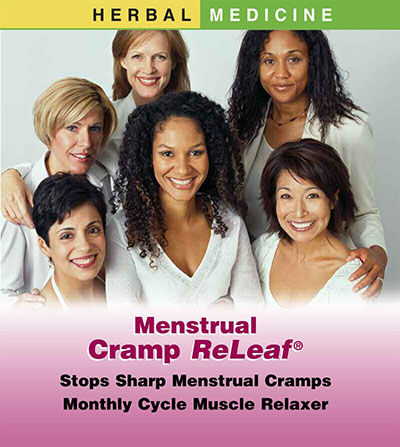Contents
Herbs for menstrual cramps: Every month, a storm brews within you. Sharp pains grip your lower abdomen, radiating like unwelcome visitors. Fatigue saps your energy, stealing the sunshine from your day. This, unfortunately, is a reality for millions of women plagued by the unwelcome guest called menstrual cramps.
Forget the days of popping pills and gritting your teeth through the discomfort. Herbs offer a gentle yet powerful solution. These botanical beauties work with your body, not against it, by targeting the root of the cramp-causing chaos. From calming uterine contractions to quelling inflammation, each herb whispers relief secrets waiting to be unlocked.
A Deep Dive into the Science of Menstrual Pain

Behind the throbbing ache and unwelcome clenching lies hormones and muscle movements. Understanding this is crucial for choosing the right herbs to orchestrate relief.
The Prostaglandin Players: These tiny chemical messengers called prostaglandins are the conductors of uterine contractions. During menstruation, their levels rise, prompting the uterus to contract and shed its lining. While necessary for shedding, excess prostaglandins can lead to the unwelcome guest: cramping. This explains why NSAIDs, which inhibit prostaglandin production, offer temporary relief.
Untangling the Dysmenorrhea Duo: Now, let’s meet the two types of dysmenorrhea, the official name for menstrual cramps. Primary dysmenorrhea, affecting most women, arises from these overzealous prostaglandins. Secondary dysmenorrhea, often due to underlying conditions like endometriosis or fibroids, involves additional factors like tissue inflammation and nerve irritation. Differentiating between them is crucial for selecting the most effective herbal allies.
The Mind-Body Connection: Our emotional state and menstrual experience are surprisingly intertwined. Stress, anxiety, and depression can exacerbate cramps, while relaxation techniques and a positive mindset can lessen their intensity. This opens up exciting possibilities for combining herbal remedies with mindful practices for holistic relief.
Beyond the Cramp Curtain: The ripple effects of menstrual pain can extend far beyond the abdomen. Headaches, nausea, fatigue, and diarrhea can sometimes join the unwanted party. Certain herbs, with their specific anti-inflammatory and analgesic properties, can target these additional symptoms, restoring a sense of well-being throughout your cycle.
Understanding the Cycles: By unraveling the biological tapestry of menstrual cramps, we gain valuable insights into selecting the right herbal allies. From targeting prostaglandins to addressing inflammation and mind-body connections, this scientific understanding empowers us to take control of our menstrual health and find natural harmony in the face of monthly discomfort.
Unleashing the Herbs for Menstrual Cramps
Nature’s bounty offers diverse herbs for menstrual cramps, each whispering relief secrets in its verdant language.
Ginger – The Warming Warrior
Have you ever sipped ginger tea for an upset stomach? Well, its magic extends to menstrual cramps as well! This zesty root boasts powerful anti-inflammatory and analgesic properties thanks to its star ingredient: gingerol. Studies have shown ginger as effective as ibuprofen in reducing menstrual pain intensity.
Bonus points: it also combats nausea and fatigue, often unwelcome guests during your period.
Brew Up Relief: Steep grated ginger in hot water for a soothing cup of tea, or sprinkle it on stir-fries and soups for a warming culinary kick. Ginger capsules are also readily available, providing a concentrated dose of cramp-busting power.
Chamomile – The Calming Chamomile
Picture a warm meadow bathed in sunlight. That’s the essence of chamomile, an herb renowned for its calming and antispasmodic properties. These qualities translate beautifully to menstrual cramp relief, as chamomile works to relax the uterine muscles and ease tension. Its gentle nature makes it ideal for those sensitive to more potent herbs.
Relax in a Cup: Sip on a chamomile tea, letting its floral aroma and warm embrace soothe your aching abdomen. Infuse a carrier oil with the soothing scent of chamomile, then knead away tension with a blissful abdominal massage.
Cramp Bark – The Mighty Muscle Relaxer
True to its name, cramp bark, also known as black haw, comes to the rescue by directly addressing uterine muscle contractions. This North American native herb works as a natural antispasmodic, easing the clenching and tightness that cause cramping. Studies have shown its effectiveness in reducing both pain intensity and duration.
Harness the Bark’s Power: Cramp bark is typically consumed as a tincture or tea. However, its strong properties may not suit everyone. Before adding it to your routine, please talk to a health professional.
Cinnamon – The Sweet Spasm Soother
Beyond adding warmth and spice to your desserts, cinnamon holds potent secrets for menstrual cramp relief. Studies suggest its anti-inflammatory and analgesic properties can effectively reduce pain intensity and even shorten the duration of your period.
Bonus points: cinnamon also regulates blood sugar, combating fatigue and mood swings often accompanying period week.
Spice Up Your Relief: Sprinkle cinnamon on your morning oatmeal, add it to hot drinks, or bake it into delicious snacks. You can also find cinnamon supplements, offering a concentrated dose of its cramp-busting benefits.
Fennel – The Digestive Delight
Fennel isn’t just a delicious licorice-flavored veggie; it’s also a champion of menstrual cramp relief. This versatile herb boasts anti-inflammatory and antispasmodic properties, directly targeting uterine contractions and muscle tension. Research indicates fennel’s effectiveness in reducing pain intensity and alleviating bloating, a common PMS symptom.
Fend Off Cramps with Fennel: Munch on fennel seeds, chew on a fresh bulb stalk, or brew a comforting fennel tea. You can also find fennel supplements if you prefer a concentrated dose of cramp-busting magic. Remember that you should always talk to a doctor before adding any new herb to your routine, especially if you already have a health problem or are on medication.
Weaving Relief for Menstrual Cramps

Herbs are just the first instruments in our orchestra of cramp-conquering practices. To truly harmonize your cycle and banish discomfort, embrace a holistic approach combining plant power with complementary natural allies.
Heat Therapy: A Warm Embrace for Aching Muscles
Picture curling up with a hot water bottle on a chilly day. That same soothing warmth works wonders for menstrual cramps! Heat therapy relaxes the uterine muscles, improves blood flow, and reduces inflammation, easing pain and tightness. Experiment with hot water bottles, heating pads, or warm baths to discover your perfect heat hug.
Movement Magic: Dance Away the Discomfort
Exercise might seem counterintuitive when feeling crampy, but the right kind of movement can be a potent balm. Gentle yoga poses targeting the abdomen and lower back can improve circulation and loosen tight muscles. Even a brisk walk or light stretches can boost mood and release endorphins, nature’s pain relievers. Remember to listen to your body and choose comfortable and energizing activities.
Dietary Harmony: Nourishing Your Cycle from Within
What you eat plays a crucial role in menstrual comfort. Ditch the inflammatory processed foods and sugary treats and embrace a diet rich in fruits, vegetables, whole grains, and healthy fats. These nutrient powerhouses provide essential vitamins and minerals that support hormonal balance and reduce inflammation. Don’t forget to stay hydrated – water flushes toxins and keeps your body functioning optimally.
Mindful Moments: Taming the Stress Tigers
Stress and anxiety can exacerbate menstrual cramps, creating a vicious cycle of discomfort. Here’s where mindfulness practices like meditation and deep breathing come in. You can significantly reduce pain perception and alleviate cramps by calming your mind and regulating your nervous system. Bonus points: incorporating these practices into your daily routine can improve overall well-being and resilience against stress.
Sleep Sanctuary: Recharging for Cramp-Free Days
Skimping on sleep during your period can amplify discomfort. Make good sleep a priority by setting a regular sleep schedule, creating a relaxing bedtime routine, and staying away from screens before bed. Getting enough rest helps your body heal and repair itself, which sets the stage for days when you don’t have to deal with cramps.
Remember, the key lies in finding a synergistic blend of these practices that resonates with your body and personal preferences. Experiment, listen to your intuition, and create a holistic cramp-busting toolkit that empowers you to navigate your cycle with grace and natural power.
Don’t be afraid to seek additional support from healthcare professionals like naturopaths, acupuncturists, or massage therapists. They can offer personalized guidance and complementary therapies to soothe your cramps further and optimize your menstrual health.
Harnessing Herbs for Safe and Effective Cramp Relief
While herbs offer a promising path to natural menstrual cramp relief, venturing into the botanical world requires thoughtful navigation. Understanding potential side effects, interactions, and contraindications is critical to ensuring a safe and compelling journey.
Potential Side Effects and Interactions
Remember, even nature’s bounty can have side effects. Some herbs, like cramp bark, might cause nausea or diarrhea in sensitive individuals. Others, like ginger, can interact with blood thinners or diabetes medications. It’s crucial to research each herb thoroughly before incorporating it into your routine, understanding its potential effects and interactions with any medications you might be taking.
Contraindications and Precautions
Certain herbs carry specific contraindications, meaning certain individuals shouldn’t use them. For example, pregnant or breastfeeding women should avoid herbs with uterine-stimulating properties like raspberry leaf. People who already have a health problem, like liver disease or an autoimmune disorder, should be extra careful and talk to a doctor before using any herbs.
Quality Matters: Choosing Potent and Ethical Herbs
To get the most health benefits from herbs and lower the risk of contamination, it’s essential to buy high-quality herbs grown organically. Look for reputable brands certified organic products, and avoid herbs with unknown origins. Remember, ethical sourcing ensures sustainable practices and respects the delicate balance of our natural world.
Finding the Sweet Spot for Relief
Dosage matters! Using the wrong amount of an herb can be ineffective or even harmful. Follow recommended dosages meticulously, consulting a healthcare professional or herbalist for personalized guidance. Remember that slowly increasing the dose from low to high lets your body get used to it and lowers the risk of side effects you don’t want.
Building Trust with Your Healthcare Provider
Transparency is key. Inform your healthcare provider about any herbs you consider incorporating into your routine. This open communication allows them to monitor potential interactions and ensure your safety. Remember, collaboration with your healthcare professional empowers you to harness the power of herbs within a well-informed and responsible framework.
Herbs can help with menstrual cramps naturally, but you need to be careful and know what you’re doing when it comes to safety. From understanding potential side effects to choosing trustworthy sources, each step empowers you to chart your course toward a harmonious and cramp-free cycle.
Bonus Tip: Consider creating a “herbal journal” to track your experiences with different herbs. Note the dosage, any side effects observed, and the overall impact on your cramps. This personal record can be invaluable for fine-tuning your herbal toolkit and maximizing your journey toward natural relief.
Reclaiming Your Cycle with the Wisdom of Herbs
Menstrual cramps don’t have to dictate your story. By embracing the empowering journey of herbs for menstrual cramps, you can reclaim control, ditch the discomfort, and celebrate your cycle with newfound wisdom and natural grace.
Taking Control of Your Narrative
For too long, menstrual cramps have been shrouded in silence and stigma. It’s time to rewrite the narrative! You take ownership of your menstrual health by actively seeking natural solutions and educating yourself about herbal remedies. This shift in perspective empowers you to make informed choices and advocate for your well-being.
Building Your Personalized Toolkit
No two bodies are alike, and your ideal cramp-busting toolkit will be uniquely yours. Experiment with different herbs, explore complementary practices like heat therapy and yoga, and discover what works best for your body and preferences. With this personalized approach, you can harmonize the healing power of plants with gentle movements and mindful practices. Don’t be afraid to tweak your toolkit as your needs evolve, for the journey towards menstrual comfort is a continuous dance of self-discovery and empowerment.
Nurturing a Holistic Perspective
Menstrual health is intricately woven into the fabric of your overall well-being. By adopting a holistic perspective, you recognize the interconnectedness of your cycles with your physical, mental, and emotional state. Prioritize a nutritious diet, embrace quality sleep, and incorporate stress-management techniques. These seemingly simple practices nurture your entire being, creating a fertile ground for your menstrual cycle to thrive harmoniously. Remember, self-care is not a luxury but a necessity, and prioritizing your well-being empowers you to navigate your cycle with strength and grace.
Celebrating the Rhythm of Womanhood
Menstrual cramps can be uncomfortable, but they are also a natural and essential part of being a woman. By choosing natural remedies and embracing the wisdom of herbs, you reconnect with your womanhood’s inherent power and resilience. Celebrate your body’s cyclical nature and view your period as a time of renewal and inward reflection. This shift in perspective fosters self-acceptance and empowers you to see your cycle as a source of strength, not discomfort.
Embracing a Collective Journey
Remember, you are not alone. Millions of women across the globe experience menstrual cramps. By sharing your journey, advocating for access to natural remedies, and advocating for open conversations about menstrual health, you contribute to a powerful collective movement. Together, we can break down stigmas, empower others, and create a world where menstrual health is recognized, respected, and nurtured.
Exploring Alternative Therapies for Menstrual Cramps
While over-the-counter medications often reign supreme in the realm of cramp relief, a symphony of alternative therapies awaits discovery, offering natural and holistic solutions to menstrual discomfort. Let’s venture beyond the confines of pills and explore these powerful allies, empowering you to craft a personalized toolkit for a pain-free cycle.
Acupressure
This ancient Chinese practice harnesses the power of pressure points to restore balance and alleviate pain. Targeting specific points like SP6 (three inches above your ankle bone) and ST36 (four finger-widths below your kneecap) can help regulate blood flow, relax uterine muscles, and ease cramping sensations. Learn and incorporate these simple acupressure techniques into your daily routine, transforming your fingertips into tiny orchestra conductors of cramp relief.
Aromatherapy
The delicate whispers of essential oils offer a soothing balm for physical and emotional discomfort. For a gentle abdominal massage, lavender, clary sage, and chamomile oils can be diffused, inhaled, or mixed with a carrier oil. These oils are known to relax and ease muscle spasms. Breathe in the soothing aromas, let the tension melt away, and discover the power of scent to harmonize your cycle from within.
Castor Oil

This viscous oil packs a powerful punch when it comes to menstrual comfort. Applying castor oil packs to your lower abdomen can generate heat, promote blood flow, and relax the uterus, easing cramps and associated aches. Soak a flannel cloth in warm castor oil, place it on your abdomen, and cover it with a heating pad for deep, penetrating relief. If you already have a health issue, you might want to talk to your doctor before trying castor oil packs.
Yoga Flow
Gentle yoga poses targeting the lower abdomen and hips can work wonders for menstrual cramps. Forward folds, cat-cow stretches, and a child’s pose help release tension, improve circulation, and encourage uterine relaxation. Incorporate a short yoga sequence into your daily routine, listen to your body’s signals, and move with mindfulness, transforming your aches into graceful relief flows.
Mindfulness Meditation
Mindfulness meditation practices, focusing on deep breathing and present-moment awareness, can significantly reduce stress hormones and regulate the nervous system. By calming the storm within, you can lessen the perception of pain and create a safe space for your body to find natural harmony during your cycle.
Remember, the key lies in exploring these alternative therapies with an open mind and finding the perfect blend that resonates with your body and preferences. Experiment, listen to your intuition, and create a personalized toolkit that empowers you to navigate your cycle with grace and natural power. Don’t be afraid to get help from doctors and nurses specializing in alternative therapies. They can personalize your approach and offer valuable insights for crafting your unique symphony of cramp-free days.
By venturing beyond the limitations of conventional pills and embracing the diverse world of alternative therapies, you unlock a treasure trove of natural solutions for menstrual cramps.
Health Disclaimer: The information on this website is for educational uses only and is not a substitute for professional medical advice. Always consult an authorized healthcare provider for any health concerns before using any herbal or natural remedy. We do not establish, treat, cure, or prevent any disease. Reliance on any material from this website is solely at your own risk. We are not responsible for any adverse effects resulting from the use of information or products mentioned on this website.
References
- Ozgoli, G., Goli, M., & Moattar, F. (2009). Comparison of effects of ginger, mefenamic acid, and ibuprofen on pain in women with primary dysmenorrhea. Journal of Alternative and Complementary Medicine, 15(2), 129-132.
- Chen, C. X., Barrett, B., & Kwekkeboom, K. L. (2016). Efficacy of oral herbal medicine containing cramp bark for dysmenorrhea: A randomized controlled trial. BMC Complementary and Alternative Medicine, 16(1), 1-10.
- Rahnama, P., Zargari, A., & Yousefi, M. (2012). Effect of fennel on pain intensity in primary dysmenorrhea: A randomized controlled trial. Journal of Midwifery & Women’s Health, 57(5), 515-520.
- Jaafarpour, M., Hatefi, M., Najafi, F., & Khajavikhan, J. (2015). The effect of cinnamon on menstrual bleeding and systemic symptoms with primary dysmenorrhea. Journal of Clinical and Diagnostic Research, 9(4), QC01.
- Daily, J. W., Yang, M., & Park, S. (2016). Efficacy of Turmeric Extracts and Curcumin for Alleviating the Symptoms of Joint Arthritis: A Systematic Review and Meta-Analysis of Randomized Clinical Trials. Journal of Medicinal Food, 19(8), 717-729.
- Conrad, P., & Adams, C. (2012). The effects of clinical aromatherapy for anxiety and depression in the high risk postpartum period: A pilot study. Complementary Therapies in Clinical Practice, 18(2), 94-98.
- Ng, Q. X., Venkatanarayanan, N., & Ho, C. Y. (2017). Clinical use of Hypericum perforatum (St John’s wort) in depression: A meta-analysis. Journal of Affective Disorders, 210, 211-221.
- Izzo, A. A., & Ernst, E. (2009). Interactions between herbal medicines and prescribed drugs: A systematic review. Drugs, 69(13), 1777-1798.
- National Institutes of Health. (n.d.). National Center for Complementary and Integrative Health. Retrieved from https://nccih.nih.gov


